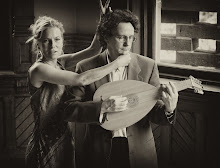The Suavity of Sound that is Born of the Lute
Apr. 26, 2014, 8PM
Heliconian Hall, Toronto
 |
| Playing these first pieces on a big lute like this one in a painting by Cariani |
Malor me bat Johannes Martini (d. 1498) arr. Spinacino
Pavana alla Ferrarese – Joan Ambrose Dalza (fl.1508)
Salterello – Piva
 |
| These next pieces on a little lute like this one also in a picture by Cariani |
Poi che volse Bartolomeo Tromboncino (d. aft. 1535) arr.Dalza
Ricercare Sesto – Giovanni Maria da Crema (fl. 1540–50)
Passamezzo Louetta – Saltarello Louetta
 |
| These next pieces on this lute after the Warwick Frei made by Mike Schreiner |
O mia ciecha e dura sorte Marco Cara (c.1470–1525) arr. Capirola
Che farala Don Michele Vincenti (fl. 1515) arr. Capirola
Et in terra pax – Josquin de Prés (c.1450–1521) arr. Capirola
Qui tolis pechata mondi
Balletto Capirola
Intermission
Ricercar Francesco da Milano (1497–1543)
De mon triste Jean Richafort (c.1480–c.1547) arr. Francesco
Fantasia de mon triste Francesco
 |
| The little lute by Mike Schreiner |
Saltarello
Ricercar del duodecimo tuono – Vincenzo Galilei (c.1520–1591)
Erato – Urania – Euterpe
 |
| A woodcut from a book of tablature by Francesco da Milano, who seems to be playing quite a big lute. |
Fantasia Cosimo Bottegari (1564–1620)
Ancor che col partire Cipriano de Rore (1515/16–1565) arr. Bottegari
 |
| And this last set on the little lute again, Bartolomeo Veneto, first decade of the 16th c. |
Forestiere – Romanesca
‘Most Gentle Spirits,’ the publisher Francesco Marcolini addresses the readers of a book of Intabolatura di leuto in 1536, ‘Although all wind and string instruments, because they retain the quality of the harmony that issues from the spheres while the heavens move, are sweet, the suavity of sound that is born of the lute, by making itself heard in the soul, robs the senses of those that hear it.’ Marcolini is putting a ‘hard sell’ on the gentle spirits of the readership, but the lute was a special instrument in the Renaissance imagination, taking the place, for them, of the Ancient Greek lyre. The lutenist was not like some ‘lacqui on the violin’, but was in the tradition of the lyrist in The Odyssey, or even the semi-divine Orpheus himself. Francesco da Milano, lutenist to two Medici popes, felt his revered position as an artist gave him license to stop playing and require two of the pope’s chatty guests to pay attention at an after-dinner concert. This at a time when crossing a Medici could get you hung out a window on a sharp hook.
 |
| A page from the Capirola Lute Book, the beginning of his arrangement of the Gloria from Josquin's Missa Pange Lingua |
Ground basses became a favourite organising principal too. The Romanesca, chord changes imported from Spain where it was called Guard My Cows and exported to England where it was called Greensleeves, was a favourite till Monteverdi’s day.
And there are the dances; from pavane (a slow dance where one parades ones finery: pavo=peacock?) and salterelli (‘little jumping’ dance), sometimes built on the passamezzo ground bass, to the more up to date gagliardi (Galilei wrote galliards to many Classical figures; here are the ones for the Muses of song, astronomy and lyric poetry) and a couple of rustic ones from Bottegari’s Songbook.


No comments:
Post a Comment